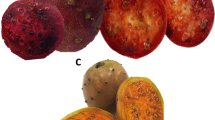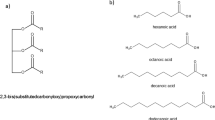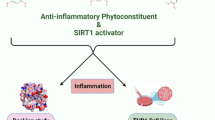Abstract
Metabolites of the 80% ethanol extract (OSE) and ethyl acetate fraction (OSEA) of oregano seed were analyzed by GC–MS, and anti-obesity effects of OSE and OSEA were evaluated in 3T3-L1 adipocyte. OSE possessed high content of glucose, fructofuranose, and sucrose while OSEA had high content of phenolic chemicals. OSEA contained higher levels of gallic acid, syringic acid, protocatechuic acid, and catechin than OSE. OSEA inhibited lipid droplet accumulation with concentration dependent manner in 3T3-L1 preadipocytes during differentiation. OSEA showed more inhibition ability than OSE by 13.7-fold at the level of 125 μg/mL. Additionally, relative mRNA and protein expression levels of pparγ, c/ebpα, fas, and srebp-1c which are related to adipogenesis were significantly lower in OSEA treatment group than in OSE treatment group (p < 0.05). Therefore, OSEA could be used as anti-obesity functional ingredient.




Similar content being viewed by others
References
Abdali D, Samson SE, Grover AK. How effective are antioxidant supplements in obesity and diabetes? Medical Principles and Practice 24: 201-215 (2015)
Choi JH, Park YH, Lee IS, Lee SP, Yu MH. Antioxidant activity and inhibitory effect of Aster scaber Thunb. extract on adipocyte differentiation in 3T3-L1 cells. Korean Journal of Food Science and Technology 45: 356-363 (2013)
Coccimiglio J, Alipour M, Jiang ZH, Gottardo C, Suntres Z. Antioxidant, antibacterial, and cytotoxic activities of the ethanolic Origanum vulgare extract and its major constituents. Oxidative Medicine and Cellular Longevity 2016: 8 (2016)
Cole SP. Rapid chemosensitivity testing of human lung tumor cells using the MTT assay. Cancer Chemotherapy and Pharmacology 17: 259-263 (1986)
Evans RM, Barish GD, Wang YX. PPARs and the complex journey to obesity. Nature Medicine 10: 355-361 (2004)
Furuyashiki T, Nagayasu H, Aoki Y, Bessho H, Hashimoto T, Kanazawa K, Ashida H. Tea catechin suppresses adipocyte differentiation accompanied by down-regulation of PPARγ2 and C/EBPα in 3T3-L1 cells. Bioscience, Biotechnology, and Biochemistry 68: 2353-2359 (2004)
Goto T, Takahashi N, Hirai S, Kawada T. Various terpenoids derived from herbal and dietary plants function as PPAR modulators and regulate carbohydrate and lipid metabolism. PPAR Research 2010: 9 (2010)
Graßmann J. Terpenoids as plant antioxidants. Vitamins and Hormones 72: 505-535 (2005)
John CM, Arockiasamy S. 3, 5-Dimethoxy-4-benzoic acid (syringic acid) a natural phenolic acid reduces reactive oxygen species in differentiated 3T3-L1 adipocytes. In Vitro Cellular & Developmental Biology - Animal 57: 386-394 (2021)
Kim SW, Kim NS, Oh MJ, Kim HR, Kim MS, Lee DY, Yoon SH, Jung MY, Kim HJ, Lee CH, Oh CH. Anti-obesity effects of fermented soybean oils in 3T3-L1 pre-adipocytes and high fat diet-fed C57BL/6J mice. Journal of the Korean Society of Food Science and Nutrition 46: 279-288 (2017)
Kim HJ, Kim B, Mun EG, Jeong SY, Cha YS. The antioxidant activity of steamed ginger and its protective effects on obesity induced by high-fat diet in C57BL/6J mice. Nutrition Research and Practice 12: 503-511 (2018)
Kim MA, Lee HJ, Bae HK, Yang SO, Lee HJ, Kim MJ. Metabolite analysis and anti-obesity effects of celery seed in 3T3-L1 adipocytes. Food Science and Biotechnology 30: 277-286 (2021)
Koliaki C, Liatis S. Kokkinos A. Obesity and cardiovascular disease: Revisiting an old relationship. Metabolism 92: 98-107 (2019)
Lagouri V, Blekas G, Tsimidou M, Kokkini S, Boskou D. Composition and antioxidant activity of essential oils from oregano plants grown wild in Greece. Zeitschrift für Lebensmittel Untersuchung und Forschung 197: 20-23 (1993)
Lee I, Kim J, Ryoo I, Kim Y, Choo S, Yoo I, Bae K. Lanostane triterpenes from Ganoderma lucidum suppress the adipogenesis in 3T3-L1 cells through down-regulation of SREBP-1c. Bioorganic & Medicinal Chemistry Letters 20: 5577-5581 (2010)
Lee DH, Chang SH, Yang DK, Song NJ, Yun UJ, Park KW. Sesamol increases Ucp1 expression in white adipose tissues and stimulates energy expenditure in high-fat diet-fed obese mice. Nutrients 12: 1459 (2020)
Lee HJ, Kim MA, Hong SS, Kim MJ. Evaluation of antioxidant properties and oxidative stability of oregano seed solvent fraction. Korean Journal of Food Science and Technology 53: 12-18 (2021)
Lim HJ, Lee S, Lee KS, Park JH, Jang Y, Lee EJ, Park HY. PPARγ activation induces CD36 expression and stimulates foam cell like changes in rVSMCs. Prostaglandins & Other Lipid Mediators 80: 165-174 (2006)
Makowski L, Brittingham KC, Reynolds JM, Suttles J, Hotamisligil GS. The fatty acid-binding protein, aP2, coordinates macrophage cholesterol trafficking and inflammatory activity: Macrophage expression of aP2 impacts peroxisome proliferator-activated receptor γ and IκB kinase activities. Journal of Biological Chemistry 280: 12888-12895 (2005)
Polyzos SA, Kountouras J, Mantzoros CS. Obesity and nonalcoholic fatty liver disease: From pathophysiology to therapeutics. Metabolism 92: 82-97 (2019)
Rayalam S, Della-Fera MA, Baile CA. Phytochemicals and regulation of the adipocyte life cycle. Journal of Nutritional Biochemistry 19: 717-726 (2008)
Seo CR, Yi B, Oh S, Kwon SM, Kim S, Song NJ, Cho JY, Park KM, Ahn JY, Hong JW, Kim MJ, Lee JH, Park KW. Aqueous extracts of hulled barley containing coumaric acid and ferulic acid inhibit adipogenesis in vitro and obesity in vivo. Journal of Functional Foods 12: 208-218 (2015)
Shang W, Yang Y, Jiang B, Jin H, Zhou L, Liu S, Chen M. Ginsenoside Rb1 promotes adipogenesis in 3T3-L1 cells by enhancing PPARγ2 and C/EBPα gene expression. Life Sciences 80: 618-625 (2007)
Sun NN, Wu TY, Chau CF. Natural dietary and herbal products in anti-obesity treatment. Molecules 21: 1351 (2016)
Tsimogiannis D, Stavrakaki M, Oreopoulou V. Isolation and characterisation of antioxidant components from oregano (Origanum heracleoticum). International Journal of Food Science 41: 39-48 (2006)
Vekic J, Zeljkovic A, Stefanovic A, Jelic-Ivanovic Z, Spasojevic-Kalimanovska V. Obesity and dyslipidemia. Metabolism 92: 71-81 (2019)
Wu Z, Xie Y, Morrison RF, Bucher NL, Farmer SR. PPARγ induces the insulin-dependent glucose transporter GLUT4 in the absence of C/EBPα during the conversion of 3T3 fibroblasts into adipocytes. Journal of Clinical Investigation 101: 22-32 (1998)
Yamauchi T, Kamon J, Waki H, Murakami K, Motojima K, Komeda K, Ide T, Kubota N, Terauchi Y, Tobe K, Miki H, Tsuchida A, Akanuma Y, Nagai R, Kimura S, Kadowaki T. The mechanisms by which both heterozygous peroxisome proliferator-activated receptor γ (PPARγ) deficiency and PPARγ agonist improve insulin resistance. Journal of Biological Chemistry 276: 41245-41254 (2001)
Zebisch K, Voigt V, Wabitsch M, Brandsch M. Protocol for effective differentiation of 3T3-L1 cells to adipocyte. Analytical Biochemistry 425: 88-90 (2012)
Zhang Q, and de Mejia EG. Protocatechuic acid attenuates adipogenesis-induced inflammation and mitochondrial dysfunction in 3T3-L1 adipocytes by regulation of AMPK pathway. Journal of Functional Foods 69: 103972 (2020)
Acknowledgements
This research was supported by Basic Science Research Program through the National Research Foundation of Korea (NRF) funded by the Ministry of Education (NRF- 2021R1F1A1060533).
Author information
Authors and Affiliations
Corresponding author
Ethics declarations
Conflict interest
The authors declare no conflict of interest.
Additional information
Publisher's Note
Springer Nature remains neutral with regard to jurisdictional claims in published maps and institutional affiliations.
Rights and permissions
About this article
Cite this article
Lee, HJ., Kim, MJ. Metabolites of oregano (Origanum vulgare) seed and their anti-obesity effects on 3T3-L1 adipocytes through down-regulated adipogenesis. Food Sci Biotechnol 31, 867–878 (2022). https://doi.org/10.1007/s10068-022-01085-0
Received:
Revised:
Accepted:
Published:
Issue Date:
DOI: https://doi.org/10.1007/s10068-022-01085-0




